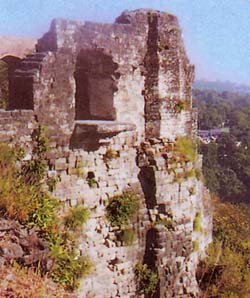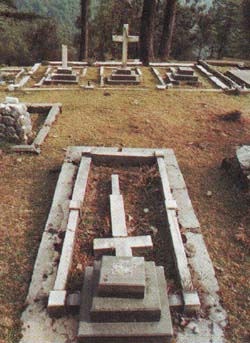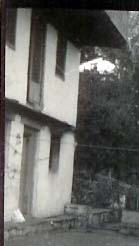Dec 25, 2025
Dec 25, 2025
People get killed during earthquakes. It is an irony that the earthquake is never the killer they get killed by the house collapse. It is yet another irony that the worst earthquakes occur during the night when people are fast asleep and taken unawares. Called as 'Kat-Ki-Kunni' in Kulu H.P. 'Pherols' in Uttarkashi in Uttaranchal and 'Dhajji-Dewari' buildings in Kashmir have one thing in common, that is the use of wooden beams as shock-absorbers in the thick walls of stone.
For northern India the Twentieth century started on a poignant note. It was 4th April 1905 when people in the quiet town of Kangra, Punjab (now in H.P.) were jolted by a massive earthquake. Records of the Punjab government show that out of a population of 375,000 more than 20,000 people perished in this tragic event. The fury of the earthquake was such that nearly 100,000 buildings were destroyed within the footprint of the earthquake and 53,000 domestic animals perished. This area was famous for its aqueducts in use for agriculture since generations. They too were obliterated. In terms of money the loss was estimated at Rs. 2.9million (in 1905!).
 So devastating was the earthquake that the famous Fort at Kangra built around ninth-tenth century AD was finally in control of the Sikh ruler Maharaja Ranjit Singh (1809). The British gained control of the Fort in 1846. Fortunately the British garrison stationed there had moved out before the Fort was devastated by the earthquake. So high was the intensity of the earthquake that the thick walls of the Fort and the intricately carved walls of Laxmi Narayan Temple built in tenth century suffered heavy damages.
So devastating was the earthquake that the famous Fort at Kangra built around ninth-tenth century AD was finally in control of the Sikh ruler Maharaja Ranjit Singh (1809). The British gained control of the Fort in 1846. Fortunately the British garrison stationed there had moved out before the Fort was devastated by the earthquake. So high was the intensity of the earthquake that the thick walls of the Fort and the intricately carved walls of Laxmi Narayan Temple built in tenth century suffered heavy damages.
The earthquake did not spare either the worship places of any religion. A Church built in 1852 at Dharamshala, a nearby beautiful town was ruined almost to rubble. It was rebuilt in 1929 and once again badly mauled by Chamba earthquake in 1945. The quake did not spare even the dead. Tell tales of the earthquake are preserved in the Churchyard. Most tombs made prior to 1905 show the signs of heavy damage. Those made post earthquake remained unscathed.
The quake did not spare even the dead. Tell tales of the earthquake are preserved in the Churchyard. Most tombs made prior to 1905 show the signs of heavy damage. Those made post earthquake remained unscathed.
The Earthquake had devastated houses in a vast area of H.P. It was amazing that some houses remained unaffected by the shaking! A study carried out by a group of structural engineers found that indigenous techniques used by the ancestors in H.P., Kashmir and Uttaranchal were a unique kind of earthquake resistant houses. 'Kat-Ki-Kunni' has thick vertical wooden beams on the corners with horizontal beams connected to them at three to five feet interval. Thus a sort of wooden lattice is made within the rock masonry. It is quite amazing that till date these houses have not been affected by the earthquakes! The Nagger Castle near Kulu now a Hotel is one of the classic examples of this type of architecture. It is worth adding here that the author's ancestral house at Almora in Uttaranchal still stands majestically since 1740 despite several earthquakes till date. The house is earthquake resistant with thick, hand chiseled Cedar wood beams as shock breakers in the masonry.
'Kat-Ki-Kunni' has thick vertical wooden beams on the corners with horizontal beams connected to them at three to five feet interval. Thus a sort of wooden lattice is made within the rock masonry. It is quite amazing that till date these houses have not been affected by the earthquakes! The Nagger Castle near Kulu now a Hotel is one of the classic examples of this type of architecture. It is worth adding here that the author's ancestral house at Almora in Uttaranchal still stands majestically since 1740 despite several earthquakes till date. The house is earthquake resistant with thick, hand chiseled Cedar wood beams as shock breakers in the masonry.
Wood is precious now and one cannot even dream of using 40 to 50cm thick and five to six meter long Cedar beams for constructing a 'safe house'. But yes earthquake resistant houses are possible. Seismology has become a specialized science now and so are the designs of such houses.
During the past 100 years the science of Seismology has developed in leaps and bounds. Though a real time forecast is still not feasible, but it is possible to predict about large magnitude earthquakes. Susan E. Hough, of the United States Geological Survey, Roger Bilham, Nicole Feldt seismologists of the Department of Geological Sciences, University of Colorado, USA and Nicholas Ambraseys of Department of Earthquake Engineering, Imperial College, London rummaged the data available on Kangra earthquake of 1905 and with additional data from field, published a paper in the prestigious science journal, Current Science (India) in May 2005. Their study has brought to light some unexpected results. The epicenter region shows a halo of enhanced intensity in 150-200km radius and as reported by earlier workers the shaking of Dehradun region few minutes later was due to yet another earthquake triggered after Kangra earthquake.
Amazingly these seismologists could lay their hands on some precious instrument records of Kangra earthquake. Those days despite seismology being in infancy the Colaba Observatory at far flung Bombay recorded the quake within moments of its occurrence. Laboratories at Gottingham and Leipzig, recorded the event within six to seven minutes of occurrence. From the patterns of these records Hough and his team mates conjecture that possibility of a major earthquake occurring in the frontal belt of Himalayas close to Delhi can not be ruled out.
A seminar to mark the Centenary of Kangra Earthquake was organized by Geological Survey Of India (GSI) in April 2005. Roger Bilham and his colleague Kali Wallace write in the Seminar Volume that Kangra earthquake was a corollary of an earlier greater earthquake that rocked western Himalayas in 1400 c . Subsequent earthquakes of 1833 and 1934 were a part of the same chain of events. Such events occur due to rupture of continental plates. One of the classic examples is the 2004 Sumatra/Nicobar/Andaman earthquake where the earlier ruptured plate was further stressed and ruptured. Taking the Nepal earthquakes as a precedent overlapping ruptures in the Himalayan plates, they conclude that a similar of greater event can not be ruled out in near future.
A.S. Arya of I.I.T. Roorkee has estimated that if an earthquake of the magnitude and intensity that struck Kangra in 1905, re-strikes the financial losses would be of the order of Rs 51.04 billion. In other words nature's ire will render us homeless, jobless destitute unless serious steps are taken.
One can not stop earthquakes from occurring. One can only strengthen his own house to save it from a collapse during the calamity. We will read about such houses and buildings after knowing about some recent quakes and developments in the seismology.
03-Sep-2006
More by : V. K. Joshi (Bijji)